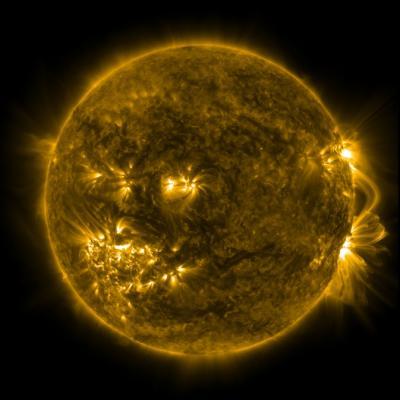In August 8th, the VERIS rocket is going to launch from the White Sands Test Facility in New Mexico.
VERIS is short for Very high Resolution Imaging Spectrometer and its 15-minute trip will carry an instrument that can measure properties of the structures in the sun's upper atmosphere down to 145 miles across, some eight times clearer than any similar telescope currently in space.
When it comes to observing the sun, different instruments and techniques must be used to study different temperatures of material or different layers of the sun from its surface out into its active upper atmosphere, the corona. VERIS will focus on the very hot material present in what's known as active regions, magnetically complex spots in the corona that are often the location of eruptions on the sun such as solar flares and coronal mass ejections, which can send radiation and solar material toward Earth, potentially disrupting satellite systems and radio communications.
After VERIS launches, it will begin to soar 150 miles up into space. When the rocket passes 60 miles, it will be above the bulk of hydrogen and water in Earth's atmosphere that block solar emissions from reaching Earth, and the instruments will begin collecting useful scientific data. Engineers on the ground will point the telescope at a pre-selected active region on the sun and gather observations for some six minutes.
During that time, the rocket will reach the peak of its trajectory and then fall back towards Earth to re-enter the atmosphere. At that point, a parachute deploys and the rocket floats back down to the ground – still within White Sands, but some 60 miles away from the launch site -- where it will be retrieved by a helicopter.

The bright regions in this solar image, known as active regions in the solar atmosphere, are areas that can spawn giant eruptions on the sun. The VERIS rocket will study the physical properties of these regions in exquisite detail during a 15-minute flight in early August 2013.
(Photo Credit: NASA/SDO)
VERIS's six-minute flight can yield such rich information partly because of the flexibility of instrument size possible on a sounding rocket. The mirror diameter is 17 inches while the entire telescope length spans almost 10 feet and weighs almost 1000 pounds, making it much too large to fly on a satellite. VERIS's telescope is unique because it is the first to gather a kind of data known as spectra of this region of the sun at such high resolution. Spectra provide information on how much of any given wavelength of light is present.
The instrument works by passing the light from the telescope through a slit and onto a grating that separates the light into its constituent wavelengths, much the way a prism can. Each wavelength corresponds to a different temperature of material – a charged gas, called plasma – present on the sun. So looking at any given wavelength can give information about just one temperature of material at a time.
The spectra can also be used to collect density and velocity information about the active region. Together, this information can help scientists distinguish between theories on what causes heat to well up from the lowest layers of the sun's atmosphere to its highest, resulting in a corona that is a mysterious 10,000 times hotter than its surface.
"On the sun, these large scale energy releases are driven by small scale physical processes," said Clarence Korendyke, principal investigator for VERIS at the United States Naval Research Laboratory in Washington, D.C. "So we need to look at and understand the tiny details of those processes."
"There are two categories of theories on how the corona is heated. One proposal is that small bursts of energy, called microflares, constantly erupt, heating the material. Another is that waves flow up from the surface to the corona," said
Angelos Vourlidas, project scientist for VERIS at the Naval Research Laboratory.
"VERIS will be able to provide temperature information at the smallest level, and help distinguish between these theories."
To support the VERIS observations, scientists will also turn to data sets gathered simultaneously by other solar observatories, such as the joint NASA-Japanese Aerospace Exploration Agency's Hinode and NASA's newly-launched Interface Region Imaging Spectrograph, which observes the lower, cooler layers of the sun's atmosphere.
A success of a mission like this also serves as a significant test to see if a similar instrument should be part of the next generation of solar telescopes, which will continue to help unravel the complex behavior of our closest star.
"Understanding the sun does not, by itself, lead to the capability for us to predict when the sun will send a burst of radiation or particles toward Earth," said Korendyke. "But at the end of the day, you can't have such a capability without first having that understanding."
VERIS was built at NRL with funding for the NASA Low Cost Access to Space program. It will launch aboard a Terrier-Black Brant IX rocket. The NASA sounding rocket program is managed for the agency at the Wallops Flight Facility in Virginia.




Comments